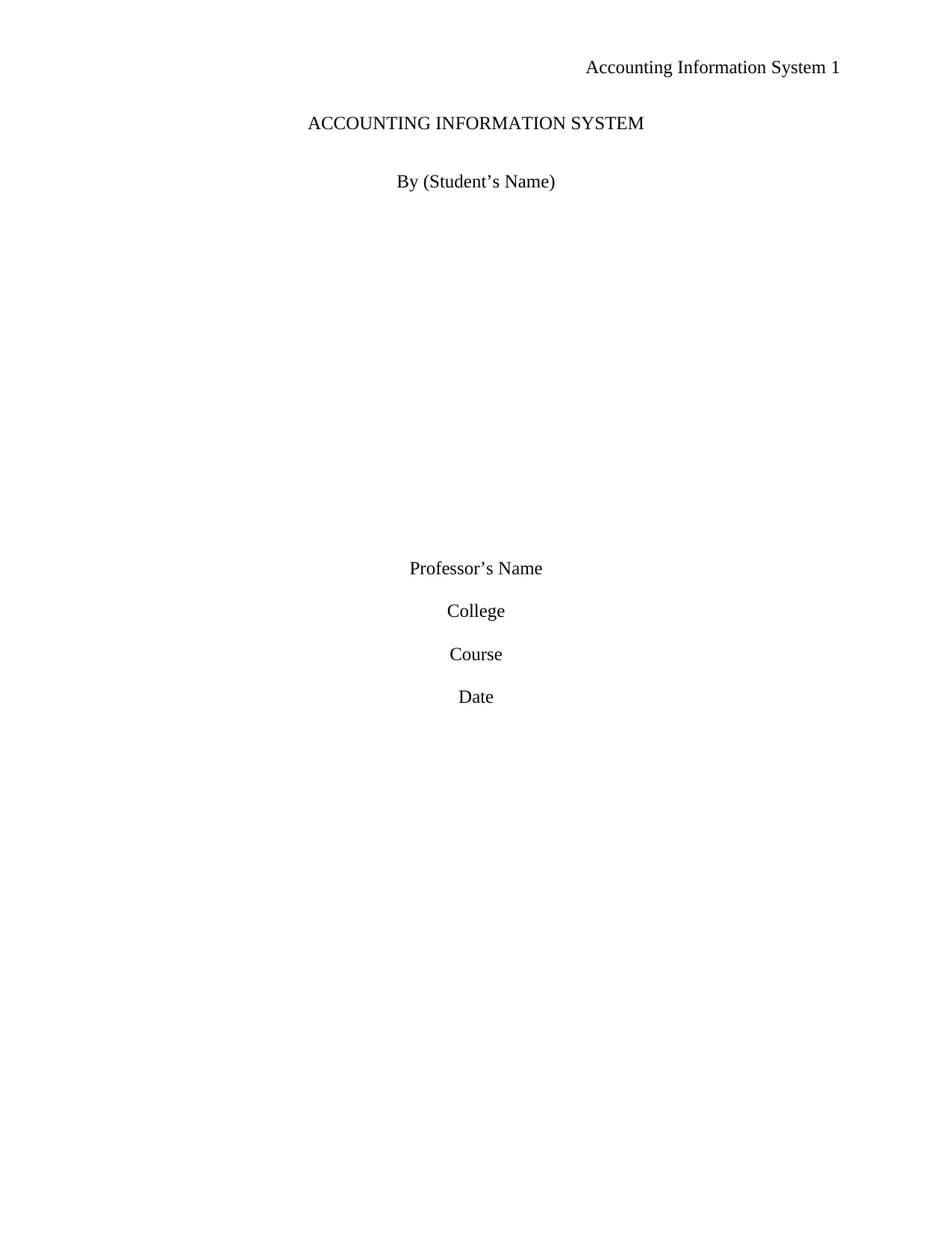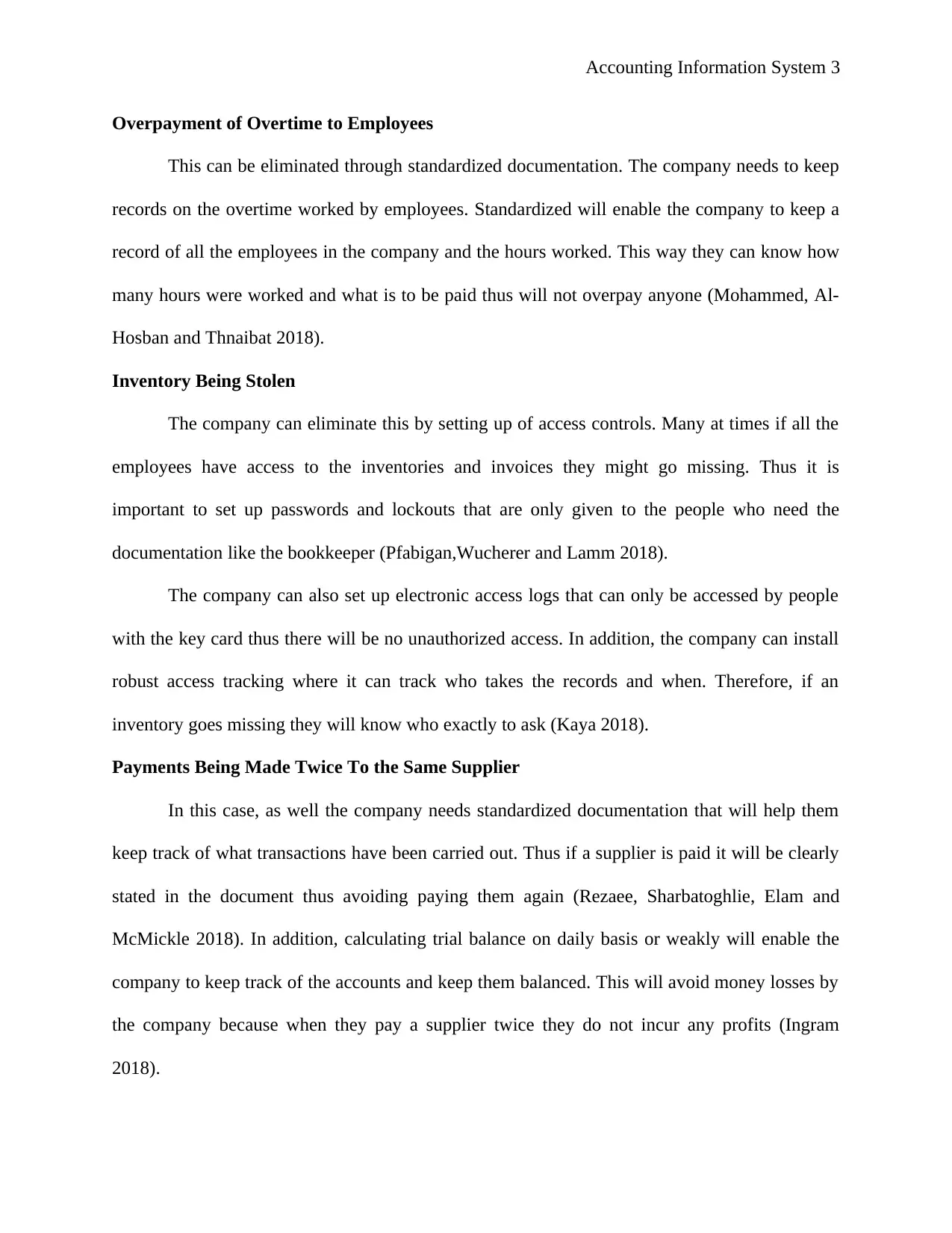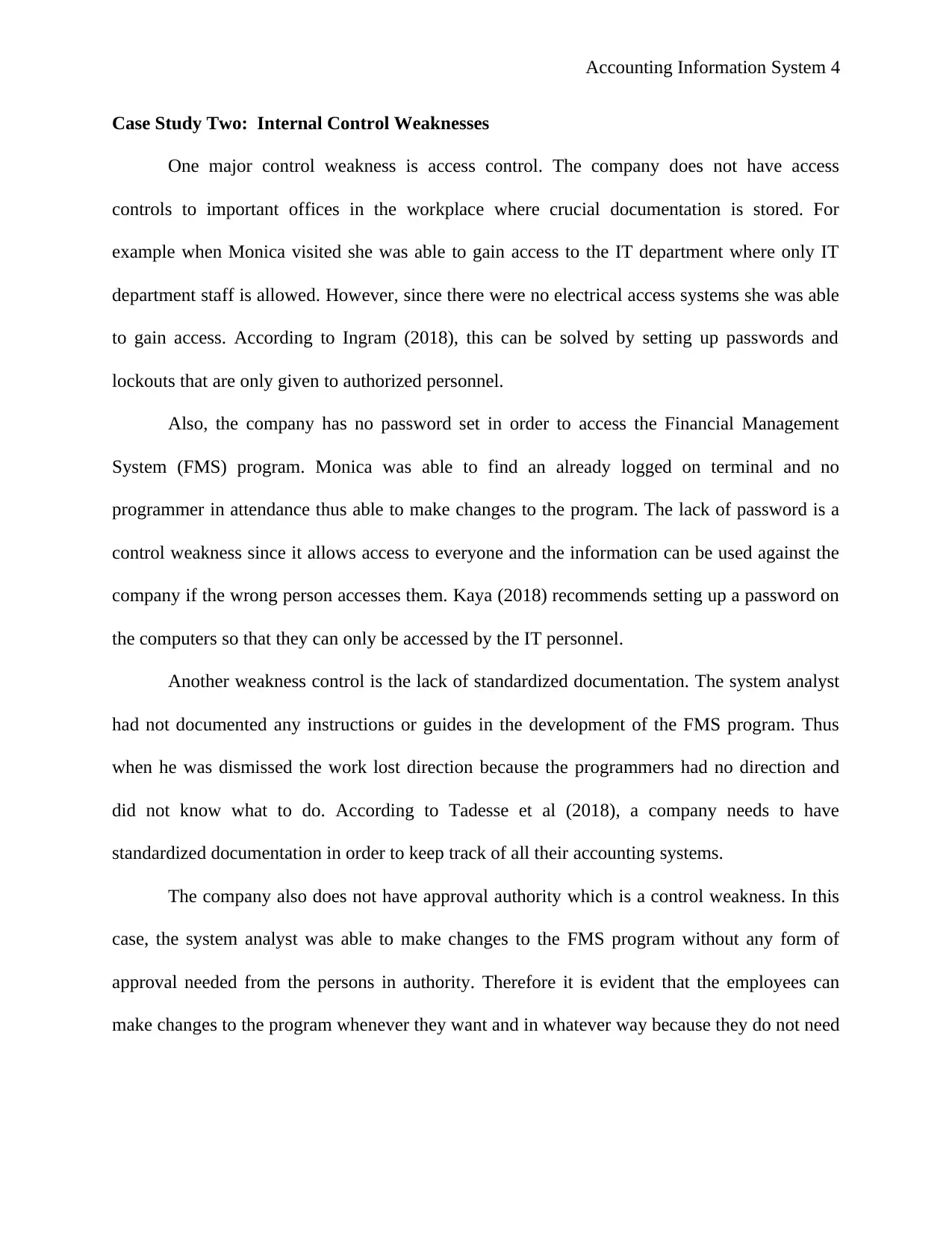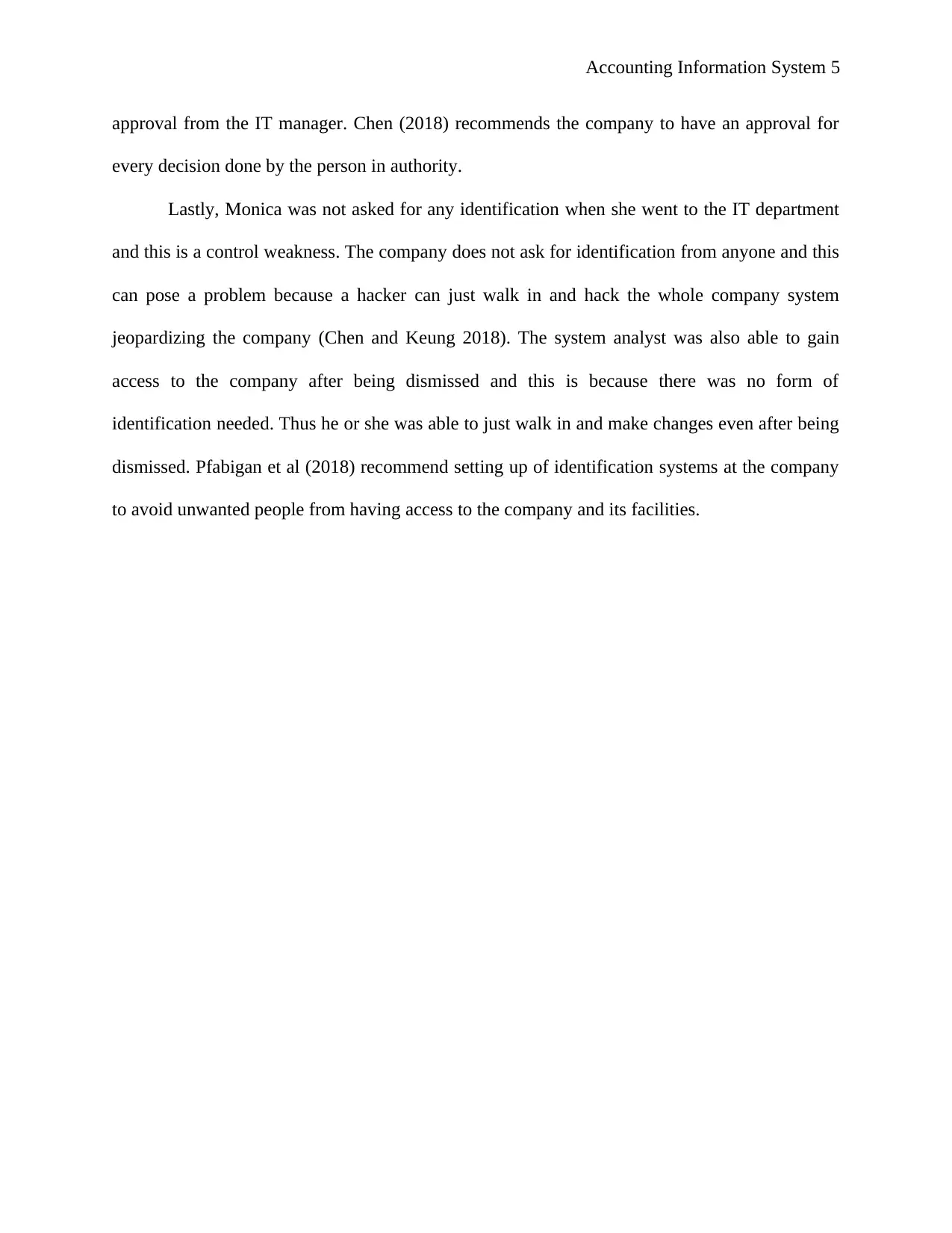Accounting Information System Case Study on Internal Controls
VerifiedAdded on 2021/05/31
|6
|1443
|27
Case Study
AI Summary
This case study analyzes the internal control procedures of Mallacoota Marina Limited to ensure the accuracy of its accounting systems. It identifies risks such as non-collectability of debt, understatement of revenue, overpayment of overtime, inventory theft, and duplicate payments to suppliers. The solution proposes implementing measures like debt liquidation, standardized documentation, access controls, and electronic tracking to mitigate these risks. The case study also highlights control weaknesses, including lack of access controls, absence of passwords, inadequate standardized documentation, lack of approval authority, and absence of identification checks. The study recommends setting up passwords, implementing standardized documentation, establishing approval processes, and setting up identification systems to strengthen the company's internal controls and safeguard its financial information.

Accounting Information System 1
ACCOUNTING INFORMATION SYSTEM
By (Student’s Name)
Professor’s Name
College
Course
Date
ACCOUNTING INFORMATION SYSTEM
By (Student’s Name)
Professor’s Name
College
Course
Date
Paraphrase This Document
Need a fresh take? Get an instant paraphrase of this document with our AI Paraphraser

Accounting Information System 2
ACCOUNTING INFORMATION SYSTEM
Case Study One: Internal Protocols
Internal protocols are procedures that are set to ensure the accuracy of accounting
systems. If the accounting records are not accurate then the finance manager at Mallacoota
Marina Limited cannot make financial decisions because the records contain areas. The
following are the internal control procedures that the company can take in order to eliminate the
risks:
Non-Collectability of Debt
Non-collectability of debt can be due to a number of reasons such as the person may not
have the money to cover the debt. In order to avoid this, the company needs to liquidate the debt.
Liquidation of a debt simply means knowing the fixed amount of dollar for that debt. In this
case, the debt is clear and is undisputed by both parties. Hence the company will know how
much a debtor owes them avoiding doubt and uncertainty of whether the debt was fully paid or
what is supposed to be paid.
Another way in which the company can eliminate non-collectability of debts is by
applying a fee to the debt if it is not paid in time. This way the debtor will be prompted to clear
to avoid extra charges (Tadesse and Murthy 2018).
Understatement of Revenue
The company can resolve this by other co-workers reviewing the invoice. The slipway
has only one bookkeeper and he is capable of making errors thus understating the revenue. The
company can decide to hire another bookkeeper to review all invoices or the co-workers can help
to review. Therefore if a mistake was made on the invoice if another worker reviews the invoice
they will see it and make a correction.
ACCOUNTING INFORMATION SYSTEM
Case Study One: Internal Protocols
Internal protocols are procedures that are set to ensure the accuracy of accounting
systems. If the accounting records are not accurate then the finance manager at Mallacoota
Marina Limited cannot make financial decisions because the records contain areas. The
following are the internal control procedures that the company can take in order to eliminate the
risks:
Non-Collectability of Debt
Non-collectability of debt can be due to a number of reasons such as the person may not
have the money to cover the debt. In order to avoid this, the company needs to liquidate the debt.
Liquidation of a debt simply means knowing the fixed amount of dollar for that debt. In this
case, the debt is clear and is undisputed by both parties. Hence the company will know how
much a debtor owes them avoiding doubt and uncertainty of whether the debt was fully paid or
what is supposed to be paid.
Another way in which the company can eliminate non-collectability of debts is by
applying a fee to the debt if it is not paid in time. This way the debtor will be prompted to clear
to avoid extra charges (Tadesse and Murthy 2018).
Understatement of Revenue
The company can resolve this by other co-workers reviewing the invoice. The slipway
has only one bookkeeper and he is capable of making errors thus understating the revenue. The
company can decide to hire another bookkeeper to review all invoices or the co-workers can help
to review. Therefore if a mistake was made on the invoice if another worker reviews the invoice
they will see it and make a correction.

Accounting Information System 3
Overpayment of Overtime to Employees
This can be eliminated through standardized documentation. The company needs to keep
records on the overtime worked by employees. Standardized will enable the company to keep a
record of all the employees in the company and the hours worked. This way they can know how
many hours were worked and what is to be paid thus will not overpay anyone (Mohammed, Al-
Hosban and Thnaibat 2018).
Inventory Being Stolen
The company can eliminate this by setting up of access controls. Many at times if all the
employees have access to the inventories and invoices they might go missing. Thus it is
important to set up passwords and lockouts that are only given to the people who need the
documentation like the bookkeeper (Pfabigan,Wucherer and Lamm 2018).
The company can also set up electronic access logs that can only be accessed by people
with the key card thus there will be no unauthorized access. In addition, the company can install
robust access tracking where it can track who takes the records and when. Therefore, if an
inventory goes missing they will know who exactly to ask (Kaya 2018).
Payments Being Made Twice To the Same Supplier
In this case, as well the company needs standardized documentation that will help them
keep track of what transactions have been carried out. Thus if a supplier is paid it will be clearly
stated in the document thus avoiding paying them again (Rezaee, Sharbatoghlie, Elam and
McMickle 2018). In addition, calculating trial balance on daily basis or weakly will enable the
company to keep track of the accounts and keep them balanced. This will avoid money losses by
the company because when they pay a supplier twice they do not incur any profits (Ingram
2018).
Overpayment of Overtime to Employees
This can be eliminated through standardized documentation. The company needs to keep
records on the overtime worked by employees. Standardized will enable the company to keep a
record of all the employees in the company and the hours worked. This way they can know how
many hours were worked and what is to be paid thus will not overpay anyone (Mohammed, Al-
Hosban and Thnaibat 2018).
Inventory Being Stolen
The company can eliminate this by setting up of access controls. Many at times if all the
employees have access to the inventories and invoices they might go missing. Thus it is
important to set up passwords and lockouts that are only given to the people who need the
documentation like the bookkeeper (Pfabigan,Wucherer and Lamm 2018).
The company can also set up electronic access logs that can only be accessed by people
with the key card thus there will be no unauthorized access. In addition, the company can install
robust access tracking where it can track who takes the records and when. Therefore, if an
inventory goes missing they will know who exactly to ask (Kaya 2018).
Payments Being Made Twice To the Same Supplier
In this case, as well the company needs standardized documentation that will help them
keep track of what transactions have been carried out. Thus if a supplier is paid it will be clearly
stated in the document thus avoiding paying them again (Rezaee, Sharbatoghlie, Elam and
McMickle 2018). In addition, calculating trial balance on daily basis or weakly will enable the
company to keep track of the accounts and keep them balanced. This will avoid money losses by
the company because when they pay a supplier twice they do not incur any profits (Ingram
2018).
⊘ This is a preview!⊘
Do you want full access?
Subscribe today to unlock all pages.

Trusted by 1+ million students worldwide

Accounting Information System 4
Case Study Two: Internal Control Weaknesses
One major control weakness is access control. The company does not have access
controls to important offices in the workplace where crucial documentation is stored. For
example when Monica visited she was able to gain access to the IT department where only IT
department staff is allowed. However, since there were no electrical access systems she was able
to gain access. According to Ingram (2018), this can be solved by setting up passwords and
lockouts that are only given to authorized personnel.
Also, the company has no password set in order to access the Financial Management
System (FMS) program. Monica was able to find an already logged on terminal and no
programmer in attendance thus able to make changes to the program. The lack of password is a
control weakness since it allows access to everyone and the information can be used against the
company if the wrong person accesses them. Kaya (2018) recommends setting up a password on
the computers so that they can only be accessed by the IT personnel.
Another weakness control is the lack of standardized documentation. The system analyst
had not documented any instructions or guides in the development of the FMS program. Thus
when he was dismissed the work lost direction because the programmers had no direction and
did not know what to do. According to Tadesse et al (2018), a company needs to have
standardized documentation in order to keep track of all their accounting systems.
The company also does not have approval authority which is a control weakness. In this
case, the system analyst was able to make changes to the FMS program without any form of
approval needed from the persons in authority. Therefore it is evident that the employees can
make changes to the program whenever they want and in whatever way because they do not need
Case Study Two: Internal Control Weaknesses
One major control weakness is access control. The company does not have access
controls to important offices in the workplace where crucial documentation is stored. For
example when Monica visited she was able to gain access to the IT department where only IT
department staff is allowed. However, since there were no electrical access systems she was able
to gain access. According to Ingram (2018), this can be solved by setting up passwords and
lockouts that are only given to authorized personnel.
Also, the company has no password set in order to access the Financial Management
System (FMS) program. Monica was able to find an already logged on terminal and no
programmer in attendance thus able to make changes to the program. The lack of password is a
control weakness since it allows access to everyone and the information can be used against the
company if the wrong person accesses them. Kaya (2018) recommends setting up a password on
the computers so that they can only be accessed by the IT personnel.
Another weakness control is the lack of standardized documentation. The system analyst
had not documented any instructions or guides in the development of the FMS program. Thus
when he was dismissed the work lost direction because the programmers had no direction and
did not know what to do. According to Tadesse et al (2018), a company needs to have
standardized documentation in order to keep track of all their accounting systems.
The company also does not have approval authority which is a control weakness. In this
case, the system analyst was able to make changes to the FMS program without any form of
approval needed from the persons in authority. Therefore it is evident that the employees can
make changes to the program whenever they want and in whatever way because they do not need
Paraphrase This Document
Need a fresh take? Get an instant paraphrase of this document with our AI Paraphraser

Accounting Information System 5
approval from the IT manager. Chen (2018) recommends the company to have an approval for
every decision done by the person in authority.
Lastly, Monica was not asked for any identification when she went to the IT department
and this is a control weakness. The company does not ask for identification from anyone and this
can pose a problem because a hacker can just walk in and hack the whole company system
jeopardizing the company (Chen and Keung 2018). The system analyst was also able to gain
access to the company after being dismissed and this is because there was no form of
identification needed. Thus he or she was able to just walk in and make changes even after being
dismissed. Pfabigan et al (2018) recommend setting up of identification systems at the company
to avoid unwanted people from having access to the company and its facilities.
approval from the IT manager. Chen (2018) recommends the company to have an approval for
every decision done by the person in authority.
Lastly, Monica was not asked for any identification when she went to the IT department
and this is a control weakness. The company does not ask for identification from anyone and this
can pose a problem because a hacker can just walk in and hack the whole company system
jeopardizing the company (Chen and Keung 2018). The system analyst was also able to gain
access to the company after being dismissed and this is because there was no form of
identification needed. Thus he or she was able to just walk in and make changes even after being
dismissed. Pfabigan et al (2018) recommend setting up of identification systems at the company
to avoid unwanted people from having access to the company and its facilities.

Accounting Information System 6
References
Chen, G.Z. and Keung, E.C., 2018. Directors' and Officers' Legal Liability Insurance and
Internal Control Weaknesses. Journal of International Accounting Research.
Ingram, D., 2018. What are the seven control procedures in Accounting? Retrieved from
http://smallbusiness.chron.com/seven-internal-control-procedures-accounting-76070.html
Kaya, İ., 2018. Perspectives on Internal Control and Enterprise Risk Management. In Eurasian
Business Perspectives (pp. 379-389). Springer, Cham.
Mohammed, A.S., Al-Hosban, A. and Thnaibat, H., 2018. The impact of the Risks of the Input of
Accounting Information Systems on Managerial Control, Accounting Control and Internal
Control in Commercial Banks in Jordan. International Journal of Business and
Management, 13(2), p.96.
Pfabigan, D.M., Wucherer, A.M. and Lamm, C., 2018. Internal control beliefs and reference
frame concurrently impact early performance monitoring ERPs.
Pharo, H.D., Andresen, K., Berg, K.C., Lothe, R.A., Jeanmougin, M. and Lind, G.E., 2018. A
robust internal control for high-precision DNA methylation analyses by droplet digital
PCR. Clinical epigenetics, 10(1), p.24.
Rezaee, Z., Sharbatoghlie, A., Elam, R. and McMickle, P.L., 2018. Continuous auditing:
Building automated auditing capability. In Continuous Auditing: Theory and Application (pp.
169-190). Emerald Publishing Limited.
Tadesse, A. F., and Murthy, U. S., 2018. Nonprofessional investor perceptions of the partial
remediation of IT and non-IT control weaknesses: An experimental investigation. International
Journal of Accounting Information Systems, 28, 14-30.
References
Chen, G.Z. and Keung, E.C., 2018. Directors' and Officers' Legal Liability Insurance and
Internal Control Weaknesses. Journal of International Accounting Research.
Ingram, D., 2018. What are the seven control procedures in Accounting? Retrieved from
http://smallbusiness.chron.com/seven-internal-control-procedures-accounting-76070.html
Kaya, İ., 2018. Perspectives on Internal Control and Enterprise Risk Management. In Eurasian
Business Perspectives (pp. 379-389). Springer, Cham.
Mohammed, A.S., Al-Hosban, A. and Thnaibat, H., 2018. The impact of the Risks of the Input of
Accounting Information Systems on Managerial Control, Accounting Control and Internal
Control in Commercial Banks in Jordan. International Journal of Business and
Management, 13(2), p.96.
Pfabigan, D.M., Wucherer, A.M. and Lamm, C., 2018. Internal control beliefs and reference
frame concurrently impact early performance monitoring ERPs.
Pharo, H.D., Andresen, K., Berg, K.C., Lothe, R.A., Jeanmougin, M. and Lind, G.E., 2018. A
robust internal control for high-precision DNA methylation analyses by droplet digital
PCR. Clinical epigenetics, 10(1), p.24.
Rezaee, Z., Sharbatoghlie, A., Elam, R. and McMickle, P.L., 2018. Continuous auditing:
Building automated auditing capability. In Continuous Auditing: Theory and Application (pp.
169-190). Emerald Publishing Limited.
Tadesse, A. F., and Murthy, U. S., 2018. Nonprofessional investor perceptions of the partial
remediation of IT and non-IT control weaknesses: An experimental investigation. International
Journal of Accounting Information Systems, 28, 14-30.
⊘ This is a preview!⊘
Do you want full access?
Subscribe today to unlock all pages.

Trusted by 1+ million students worldwide
1 out of 6
Your All-in-One AI-Powered Toolkit for Academic Success.
+13062052269
info@desklib.com
Available 24*7 on WhatsApp / Email
![[object Object]](/_next/static/media/star-bottom.7253800d.svg)
Unlock your academic potential
Copyright © 2020–2025 A2Z Services. All Rights Reserved. Developed and managed by ZUCOL.


